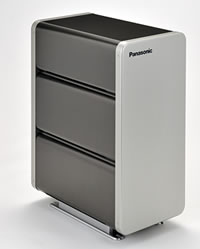Panasonic has developed a 1.5 kWh battery module from 18650-type (18 mm in diameter x 65 mm in length) lithium-ion battery cells, which are widely used in laptop computers, to provide energy storage solutions for a wide range of environmentally friendly energy technologies.

For example, multiple units can be connected in series and/or parallel to store energy generated by home-use photovoltaic (PV) systems and fuel cells, and power electric vehicles (EV). A prototype of the new module will be shown at CEATEC JAPAN 2009 (Makuhari Messe, October 6-10, 2009) and New Energy Industry Fair Osaka (Intex Osaka, October 7-9, 2009).
Among a number of energy storage technologies, storage systems using lithium-ion batteries in particular are considered promising and practical, because such systems are lighter and have greater capacity than those using other types of rechargeable batteries.
As applications of the storage systems using lithium-ion batteries increase, there will arise demand for such systems with higher capacity, output, reliability and safety as well as improved cost performance. Flexibility in voltage and capacity will also be required according to the application.
Panasonic claims that its compact and high-energy battery module meets such demands. The module having a volume of approximately 7 L and weighing 8 kg has a voltage of 25.2 V and a capacity of 58 Ah. By connecting a plurality of this module, users can construct battery packs for a variety of applications such as home electricity storage and electric vehicles.
The high-energy module is constructed from 140 pieces of 18650-type lithium-ion battery cells - seven serially connected rows with each row made of 20 parallel connected battery cells. This structure allows for avoiding serious loss in the system performance such as system shutdown even if some individual cells fail.
To achieve the module, Panasonic employed a high-capacity and high-durability cell technology using its proprietary nickel-based positive electrode material. Other technologies used include its cell safety technology that uses a heat-resistant insulating layer between the positive and negative electrodes to prevent short circuits and thermal runaway (overheating) which can be caused when foreign particles get mixed into the battery cell. The new module also uses Panasonic's design technology to ensure reliability by minimizing the effects on power supply if a trouble occurs in some of the cells contained in the module.